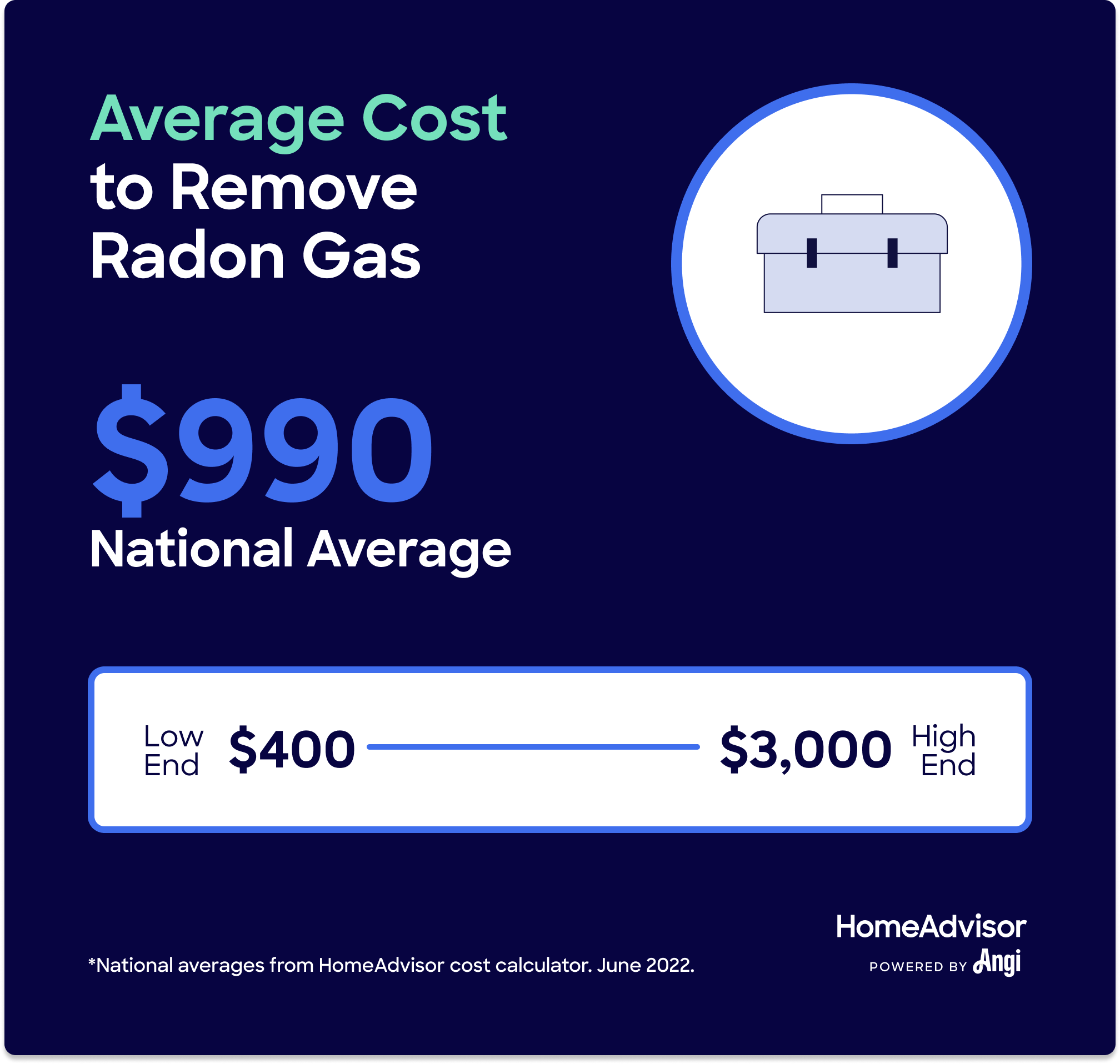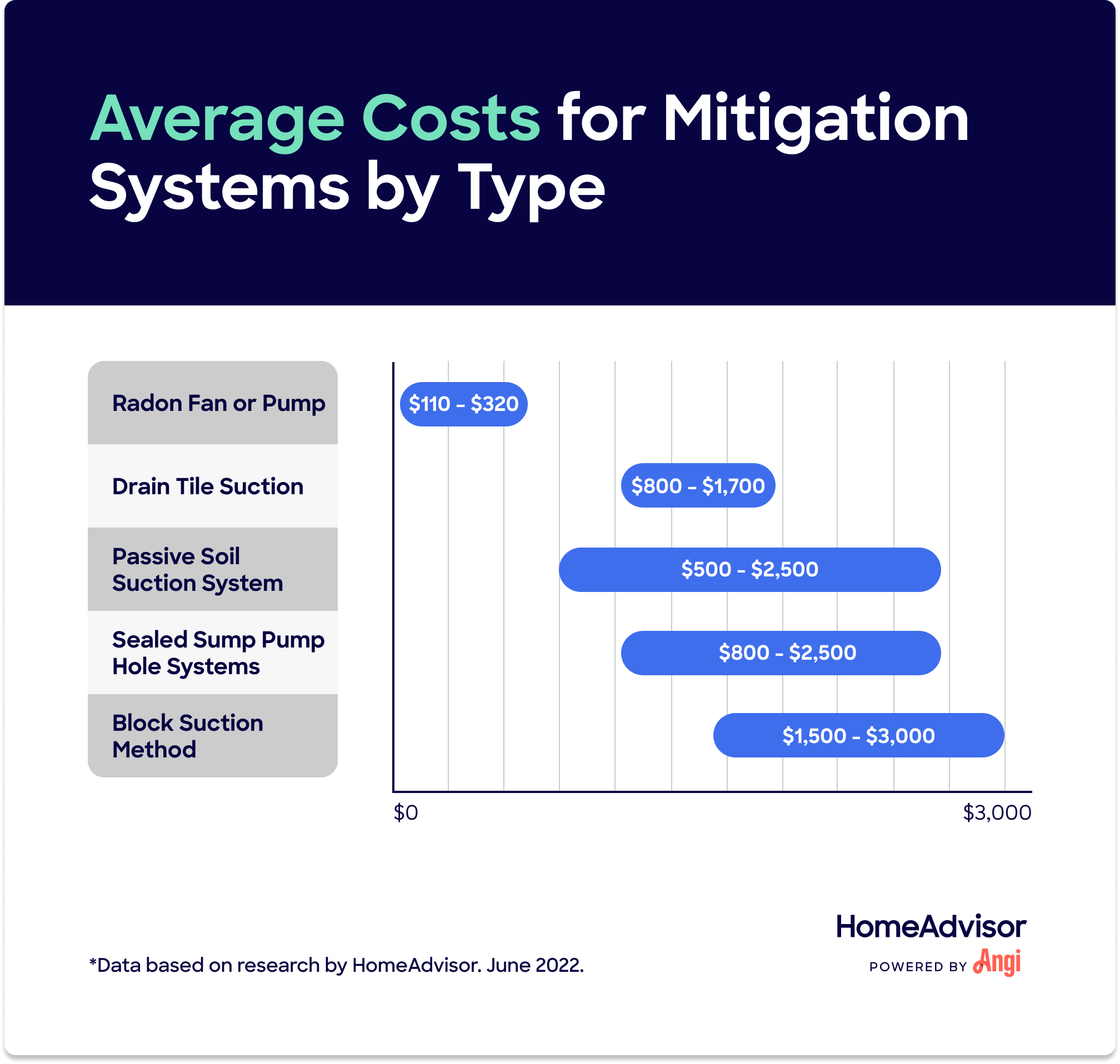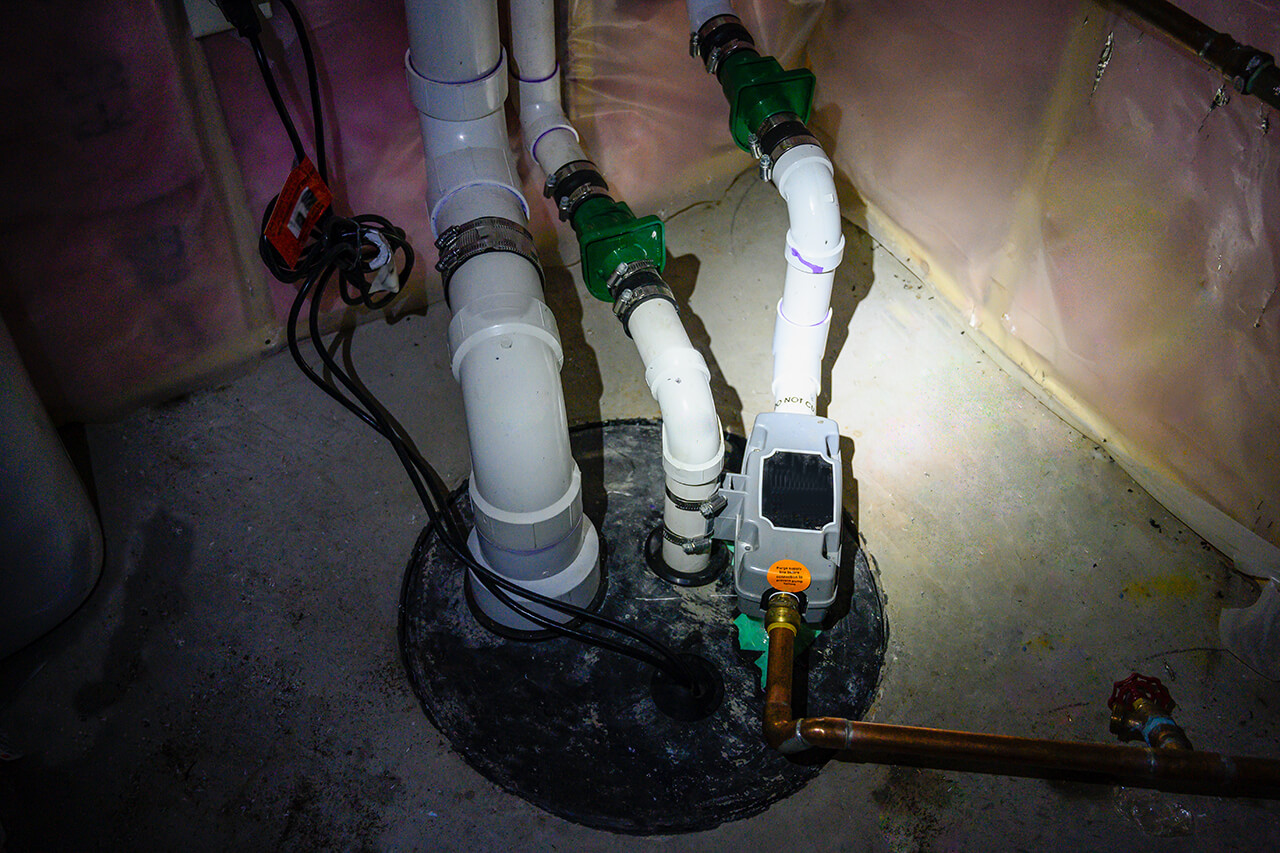How Much Does a Radon Mitigation System Cost to Install?
Typical Range:
$781 - $1,257
Typical Range:
$781 - $1,257
Cost data is based on actual project costs as reported by 4,530 HomeAdvisor members. Embed this data
.
.
.
.
.
.
.
.
.
.
.
.
.
.
.
.
.
.
.
.
.
.
.
.
.
.
.
.
.
.
•
•
•
•
Updated April 16, 2024
Written by HomeAdvisor.Hiring a pro for radon mitigation ensures accurate quoting, proper installation, and compliance with local permits and regulations.
The average cost of radon mitigation systems varies widely, from $500 to $5,000, depending on the type and complexity.
Location, labor and permits, testing and inspection, and foundation improvements impact the cost of radon mitigation systems.
Popular materials for radon mitigation include plastic vapor barriers, PVC pipe, and radon fans.
Signs you need a radon mitigation project include testing positive for radon in your home or water supply.
The project benefits include reducing radon gas, enhancing air quality, and ensuring home and family safety.
Highlights were summarized from this existing cost guide text using automation technology and were thoroughly reviewed for accuracy by HomeAdvisor Editor Ryan Noonan.
The national average cost to install a radon mitigation system is $1,019, with a typical range between $781 and $1,257. In larger homes, or those with complex designs, costs may reach as high as $3,000—especially if you opt for not traditional testing like the block suction method.
You can find Radon gas in newer and older homes. Actual mitigation costs will depend on the home’s layout, type of foundation, and geographic location.
Let's calculate cost data for you. Where are you located?
Where are you located?
| National Average | $1,019 |
| Typical Range | $781 - $1,257 |
| Low End - High End | $400 - $1,725 |
Cost data is based on actual project costs as reported by 4,530 HomeAdvisor members.
Done properly, a radon mitigation system is designed specifically for your unique home. This means your costs may differ from the national average based on the following factors.
The local cost of living, the number of specialists working in your area, and any EPA regulations specific to your region will impact mitigation rates.
Your contractor might also recommend a different radon mitigation method based on your home’s geographical location. In colder climates, adding extra ventilation can increase the amount of insulation needed on sewer lines and water pipes, as well as the energy costs to heat your home.
Your project total will usually include labor, and more experienced contractors will charge more. Because radon gas poses a health risk, you want to hire a highly experienced company that will ask the right questions to provide an accurate quote. When comparing rates between companies, ask for fixed quotes upfront.
Some cities and towns may require a permit for radon mitigation work. These permits usually come with a fee of $25 to $150, and you’ll likely need to secure additional permits and inspections if the project involves additional electrical work. If your mitigation plan involves a radon fan, you’ll need to hire a licensed electrician to wire and install it.
If you suspect radon in your home or water supply, you can hire a professional to do a test for $150 to $800. You can also opt to purchase a DIY radon testing kit for $12 to $250, though the results are not as reliable.
Your home’s foundation will help determine the radon mitigation method required, which can impact costs. In homes with fully unfinished basements, your contractor might suggest basement sealing in conjunction with an active or passive ventilation system. This costs approximately $4,600.
Homes with a crawl space but no foundation slab may require encapsulation. Crawl space encapsulation costs anywhere from $1,500 to $15,000. This involves installing plastic vapor barriers and sealing them along their edges, with PVC pipe underneath to create a vacuum. If you also have an exterior mitigation system installed, you usually get a price break on your total cost.
There are two main types of radon mitigation systems. Active suction systems, also called soil depressurization systems, are the most common. These use a fan to create a vacuum that removes trapped gas under your foundation. Passive depressurization systems do not use a fan—they rely on your home’s naturally rising air to remove gas through a system of pipes.
| Mitigation Type | Average Cost |
|---|---|
| Radon Fan or Pump | $110 – $320 plus $30 to $300 annually |
| Drain Tile Suction | $800 – $1,700 |
| Sealed Sump Pump Hole Systems | $800 – $2,500 |
| Block Suction Method | $1,500 – $3,000 |
| Passive Soil Suction Systems | $500 – $2,500 |
Fans cost $100 to $300 or more depending on size and power. You'll need a suction monitor or u-tube manometer to monitor suction for an additional $10 to $20. Fans run continuously, using an additional $30 to $300 in power annually, depending on the size and local power prices. They are usually quiet and installed in attics or at ground level for exterior installations.
Drain tile suction systems cost $800 to $1,700 or more. These tap into the drain tiles surrounding a house’s slab, creating a suction field under the foundation. Basements with slab foundations in areas with high water tables or drainage issues often use drain tiles. They can be internal, under the slab, or placed around the exterior footings. Installation costs will vary depending on placement.
It costs $800 to $2,500 to install systems that tap into the existing sump pump basin. The top of the crock is sealed completely to keep the vacuum under the foundation. These systems are often connected to drain tiles when available. If you're looking to install a mitigation system and a sump pump,sump pump installation costs an additional $700 to $2,000.
Block wall suction systems cost $1,500 to $3,000 using cinder block construction. This system creates suction within hollow walls. It is both costlier and less effective than sub-slab systems.
Passive soil systems cost $500 to $2,500 to install. They work identically to active systems minus the fan. PVC runs from under the slab or in the crawlspace up through the house or exterior wall and vents above the roof. Since radon is much heavier than air, they are not effective in homes with high levels of radon. Upgrading to these systems simply requires a fan and adequate space.
Radon has a minimal effect in water, but it can be released into the air through showers, dishwashers, or taps and become harmful when airborne. A pro will do water mitigation one of two ways:
Aeration systems cost $4,000–$5,000. These are highly effective, removing 90% to 95% of radon by quietly injecting air into the water, capturing gas, and venting it outside.
Carbon filter scrubbing, or charcoal scrubbing, costs $500 to $1,500. These systems remove about 75% of radon from your water and clean out other metals and chemicals.
The EPA does not recommend DIY radon mitigation, but you can do a few aspects of mitigation on your own. For example, sealing an unfinished basement can be done as a DIY project for $400 to $1,000. However, this type of system will not mitigate radon levels completely and works best alongside a suction system that removes gas from your home by creating a vacuum.
To properly remove radon gas and avoid compromising your home’s air quality, hire professional radon mitigators. Pros can give you confidence that your home and your family are safe.
Finding the right mitigation specialist requires a little comparative investigation. Check reviews and ratings for any professional you find and always ask about experience and any licenses or certifications they have. You can find radon mitigators near you through our database of screened and qualified professionals.
While you should avoid installing a radon mitigation system on your own, you can buy a DIY radon testing kit to learn with the system is even necessary.
DIY kits are available for $12 to $250. They help monitor your home’s radon levels and determine whether you need to install a mitigation system, but they are better for screening and should not replace a professional test. You’ll see two types available from online retailers and home improvement stores:
Short-term Radon Testing Kits: $12-$50. Great for initial screenings but offer questionable results. They test for 48 to 72 hours and then send the results to a lab.
Home Radon Digital Monitors & Smart Devices: $150-$250. Excellent for long-term measurements and provide results more comparable to professional testing. Best for monitoring after a professional test or a mitigation system installation. They work with a simple portable digital device left in your home's lowest level
Radon gas is an invisible, odorless, radioactive gas that occurs naturally deep within the soil, formed by the natural decay of uranium in rock and soil deep in the earth. It moves through air and water and has a decay life of approximately four days. This means gas can build up quickly depending on ventilation.
All 50 states have radon, though it's more common in the Northeast, Midwest and Northern Mountain Regions. Radon is the second leading cause of lung cancer in the United States with an estimated 21,000 preventable deaths per year according to the CDC. It's the second leading cause among smokers or those who have smoked cigarettes and the first leading cause among non-smokers.
The easiest way to know if you have radon in your home or water supply is to have a professional come and do a test. Professional radon testing costs$150 to $800.Learn more about radon testing.
Radon inspectors and treatment professionals are not the same. However, they often work out of the same office. Inspectors test your home while treatment pros install mitigation systems. Some pros play the role of both inspector and installer.
Repair or replacement of a radon fan can cost $150 to $400. The same professionals you hired to install your system are generally the ones you call for repairs.
Having a professional mitigation expert install a system designed specifically for your home will reduce the gas to safe levels. Improperly installed systems and DIY fixes can often make the problem worse.
The average radon fan uses about 876 kWh of electricity per year, though the exact amount will vary depending on the size of the fan. Assuming the average cost of a kWh is $0.10, the annual cost will range from $30 to $300, depending on the size of the fan.
Open windows and doors do not always help get rid of radon gas. They may create air suction through a stack effect, which sucks more radon-saturated air into the lower part of the home and worsens the problem. An active suction mitigation system is the best and safest way to get rid of radon. Talk to a pro about radon mitigation system installation costs.


